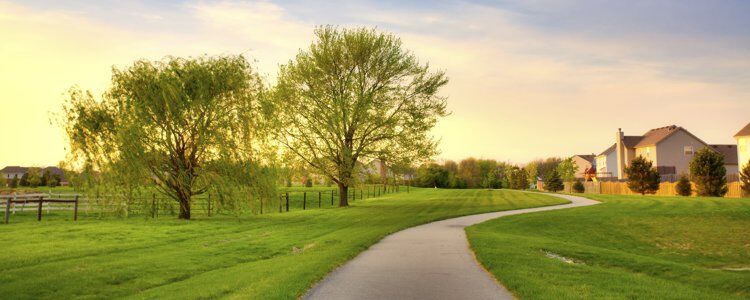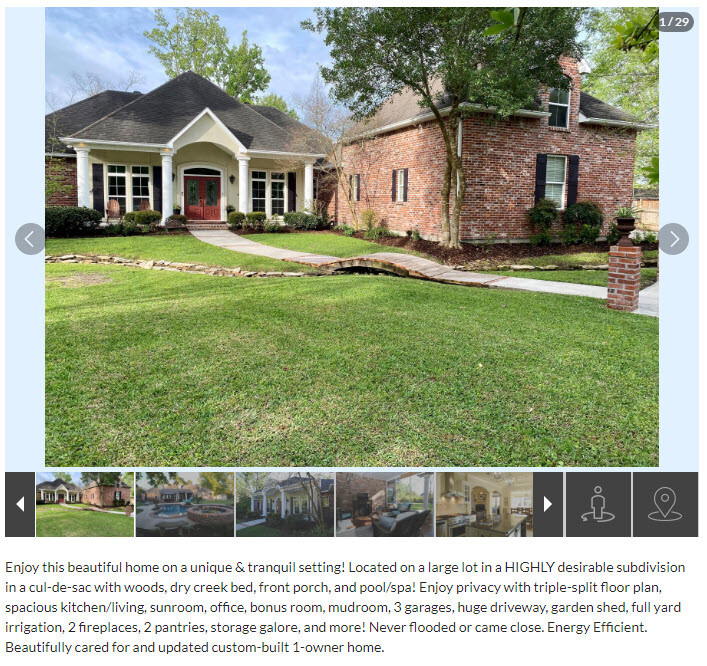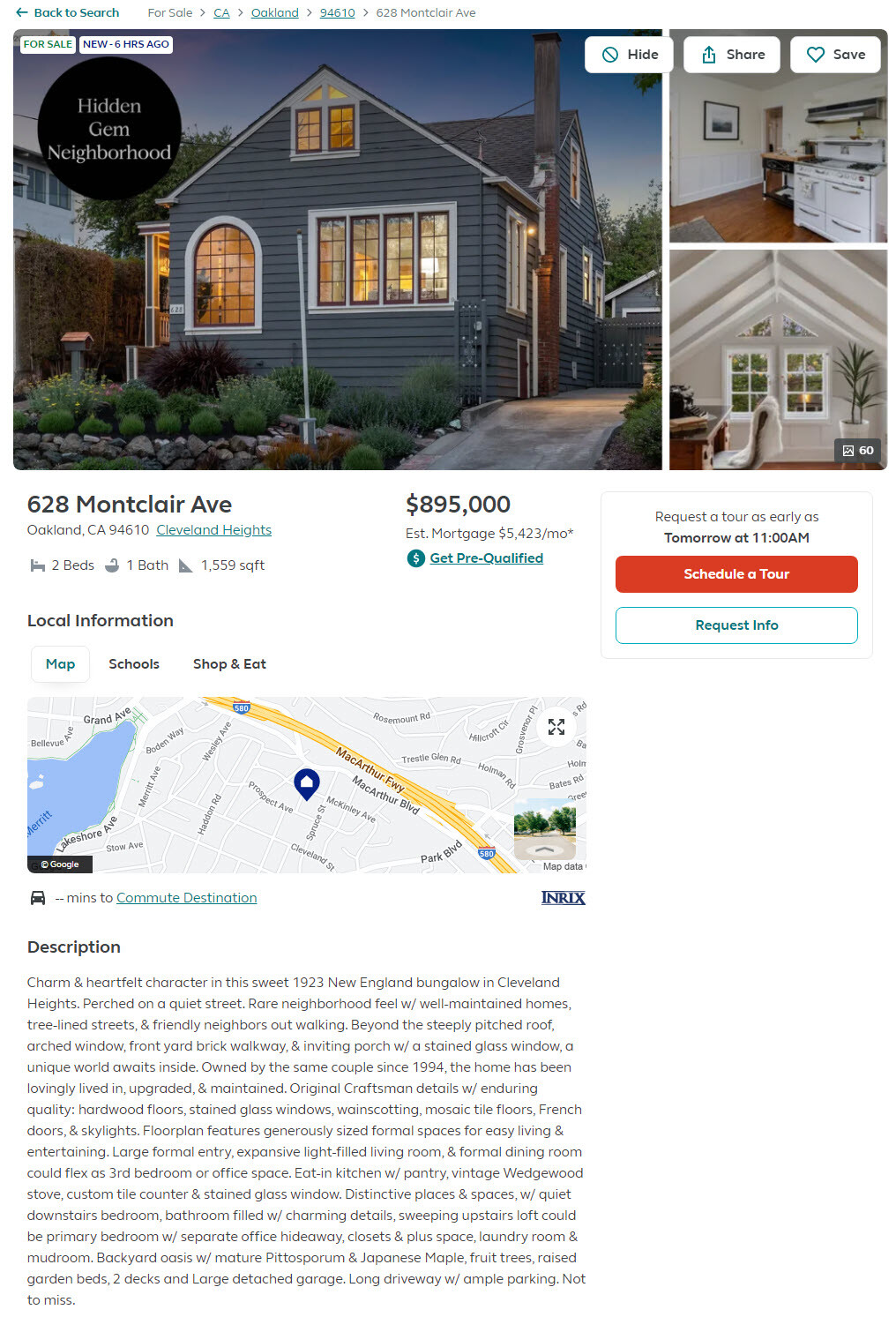The quick start guide to
Real Estate Copywriting
Write Property Listings That Connect, Captivate and Sell

CHAPTER 1
Introduction to Real Estate Copywriting

Copywriting for the Real Estate Industry
In today's competitive real estate market, standing out from the crowd is more crucial than ever. Whether you're a real estate agent or a property investor, the ability to convey your message effectively can make all the difference in achieving success. That's where real estate copywriting comes in.
Real estate copywriting is the art of crafting persuasive and engaging content that showcases properties and entices potential buyers to take action. Effective copywriting can help you:
Grab the attention of your target audience:
A well-crafted property listing or advertisement can catch the eye of potential buyers and persuade them to take a closer look.
Build trust and credibility:
By providing accurate, informative, and engaging content, you position yourself as an industry expert and a reliable source of information.
Drive more leads and conversions:
Compelling copy can encourage potential buyers to schedule a viewing, sign up for your newsletter, or get in touch to learn more about your services.
The Power of Copy in Property Sales
Compelling real estate copy has the power to transform a mundane property listing into a must-see opportunity. It can evoke emotions, spark the imagination, and inspire action. Here are some ways that great copy can impact property sales:
Emotional connection:
A well-written property description can help potential buyers envision themselves living in the space, creating an emotional connection that encourages them to take the next step.
Example:
"Imagine waking up each morning to the sound of waves crashing on the shore, just steps from your own private beach paradise."
Highlighting unique features:
By emphasizing the special qualities of a property, your copy can pique the interest of potential buyers who are looking for something distinctive.
Example:
"This one-of-a-kind, architecturally designed masterpiece boasts floor-to-ceiling windows that flood the open-concept living space with natural light."
Creating a sense of urgency:
By crafting copy that conveys the idea that a property is in high demand, you can inspire potential buyers to act quickly before they miss out.
Example:
"Don't miss your chance to own this coveted corner unit with unobstructed city views – it won't last long on the market!"
Remember, the ultimate goal of real estate copywriting is to persuade the reader to take action. With a friendly tone, informative writing style, and persuasive language, you can harness the power of compelling copy to boost your property sales and elevate your real estate career.
CHAPTER 2
Understanding Your Target Audience

Identifying Your Ideal Client
To create captivating real estate copy, it's essential to know who you're writing for. Identifying your ideal client helps you tailor your message and connect with the right audience. To determine your ideal client, consider the following questions:
For example:
If you specialize in selling luxury waterfront properties, your ideal client may be high-income earners looking for a vacation home or a stunning primary residence with access to water-based activities.
Analyzing Buyer Personas
A buyer persona is a semi-fictional representation of your ideal client based on market research and real data about your existing customers. Creating buyer personas can help you better understand your target audience and guide your copywriting efforts. Here's how to develop buyer personas for your real estate business:
Gather data:
Conduct market research, analyze your existing customer base, and gather insights from your sales team to develop a comprehensive understanding of your target audience.
Identify patterns and trends:
Look for commonalities among your audience, such as demographics, income bracket, lifestyle choices, and home preferences.
Create detailed personas:
Craft 2-3 detailed buyer personas, including their goals, challenges, and motivations related to real estate, home ownership, renting, etc.
Example:
"Empty Nesters Ellen and David – a married couple in their late 50s, looking to downsize to a low-maintenance, luxury townhouse near their grandchildren."
Crafting Copy that Speaks to Your Audience
Once you've identified your ideal clients and developed buyer personas, you can create copy that resonates with them. Keep these tips in mind when crafting copy for your target audience:
Use relatable language:
Write in a tone and style that your audience can easily understand and relate to. For example, if you're targeting first-time homebuyers, use a friendly, approachable tone that breaks down complex real estate jargon.
Address their needs and desires:
Speak to your audience's specific pain points and aspirations, demonstrating how a property can fulfill their unique requirements. For example, if your target audience consists of families, emphasize the nearby schools, parks, and family-friendly amenities.
Personalize your approach:
When possible, tailor your copy to specific buyer personas to create a deeper connection with your audience. For example, if your target audience includes Empty Nesters, highlight the low-maintenance aspects of a property, such as a small yard or an HOA that handles exterior upkeep.
By understanding your target audience and crafting copy that speaks to their unique needs and desires, you can create engaging, persuasive real estate content that resonates with potential buyers and encourages them to take action.
CHAPTER 3
Irresistible Headlines For Real Estate Copywriting

The Role of Headlines in Real Estate Copywriting
Headlines play a crucial role in real estate copywriting, as they are often the first thing potential buyers see when browsing listings or reading your marketing materials. An engaging headline can pique their interest, compelling them to read more and ultimately take action. Some of the key functions of headlines in real estate copywriting include:
Capturing attention:
A well-written headline grabs the reader's attention and encourages them to explore the property further.
Conveying key information:
An effective headline communicates essential details about the property, such as location, size, or unique features.
Setting the tone for the listing:
The headline sets the tone for the rest of your copy, giving readers an idea of what to expect as they continue reading.
Techniques for Crafting Powerful Headlines
To create compelling headlines that attract potential buyers and generate interest in your property listings, consider the following techniques:
Use strong, descriptive language:
Choose words that evoke emotion and paint a vivid picture of the property in the reader's mind. Examples: "Luxurious Oceanfront Oasis" or "Charming, Sun-Filled Cottage"
Highlight unique features:
Emphasize the aspects of the property that set it apart from other listings in the area. Examples: "Modern Penthouse with Panoramic City Views" or "Historic Victorian Home with Original Details"
Create a sense of urgency:
Encourage potential buyers to act quickly by implying that the property may not be available for long. Examples: "Rare Opportunity: Move-In Ready Family Home" or "In-Demand Corner Unit with Private Terrace"
Keep it concise:
Aim for a headline that's short and to the point, making it easy for readers to quickly grasp the property's main selling points. Examples: "Spacious 4-Bedroom in Desirable Neighborhood" or "Stylish Studio Steps from Downtown"
Examples of Captivating Headlines
To help you craft your own irresistible headlines, here are some examples to inspire your creativity:
Remember, the goal of your headline is to grab the reader's attention and entice them to learn more about the property. By using powerful language, highlighting unique features, and keeping your headline concise, you can create captivating headlines that help your property listings stand out in a competitive real estate market.
CHAPTER 4
Creating Captivating Property Descriptions

Anatomy of an Engaging Property Description
An engaging property description is a key component of successful real estate copywriting. It should provide essential information about the property while also capturing the reader's imagination. Here's a breakdown of the elements that make up an effective property description:
Opening statement:
Start with a strong, attention-grabbing sentence that highlights the property's most impressive features or unique selling points.
Example:
"Nestled on a quiet, tree-lined street, this beautifully updated Victorian home offers historic charm with modern amenities."
Detailed description:
Provide a thorough overview of the property's features, including size, layout, number of bedrooms and bathrooms, and any notable upgrades or finishes.
Example:
"Featuring four spacious bedrooms, three full baths, and a newly remodeled chef's kitchen with high-end appliances, this home offers both style and function."
Location and neighborhood highlights:
Describe the property's location and emphasize any nearby attractions, amenities, or desirable neighborhood features.
Example:
"Conveniently located just minutes from award-winning schools, shopping, and dining, this home offers the best of suburban living with easy access to the city."
Call to action (CTA):
Conclude your description with a compelling CTA that encourages potential buyers to take the next step, such as scheduling a viewing or contacting you for more information.
Example:
"Don't miss this incredible opportunity – schedule a private showing today!"

Elevate @ Apartments.com
Showcasing the Property's Unique Features
To create a captivating property description, focus on showcasing the aspects of the property that set it apart from other listings. Consider the following tips when highlighting the property's unique features:
Be specific:
Instead of using generic phrases like "spacious" or "updated," provide concrete details about what makes the property special.
Example:
"The open-concept kitchen boasts custom cabinetry, a large island with seating, and top-of-the-line stainless steel appliances."
Use vivid language:
Choose descriptive words that help the reader visualize the property and its features.
Example:
"The sun-drenched living room features soaring ceilings, gleaming hardwood floors, and a cozy fireplace."
Prioritize the most important features:
While it's essential to provide a comprehensive overview of the property, focus on the features that are most likely to appeal to your target audience.
Example:
"The backyard oasis includes a sparkling saltwater pool, a covered patio for alfresco dining, and a lush, professionally landscaped garden."
Crafting Copy that Elicits Emotion
To truly connect with potential buyers, your property description should evoke emotions and inspire them to imagine themselves living in the space. Here are some strategies for crafting emotionally compelling copy:
Paint a picture:
Use descriptive language to create vivid mental images of the property and its features.
Example:
"Imagine enjoying your morning coffee on the expansive wraparound porch, surrounded by the tranquil sounds of nature."
Tell a story:
Weave a narrative that highlights the property's unique qualities and the lifestyle it offers.
Example:
"The spacious, open-concept living area is perfect for hosting lively family gatherings or quiet movie nights with your loved ones."
Tap into the reader's aspirations:
Speak to your audience's desires by emphasizing how the property aligns with their goals and preferences.
Example:
"This elegant, move-in-ready home offers the perfect blend of style and convenience, allowing you to live the life you've always dreamed of."
By crafting an engaging property description that showcases the property's unique features and elicits emotion, you can create a compelling narrative that resonates with potential buyers and motivates them to take action.
CHAPTER 5
Fine-Tune Your Real Estate Copywriting Skills

Analyzing Successful Real Estate Listings
One of the most effective ways to improve your real estate copywriting skills is to study successful property listings and advertisements. By analyzing what works, you can glean insights and inspiration for your own copywriting. Here's how:
Identify top-performing listings:
Look for properties in your market that have generated a lot of interest or sold quickly, and examine their marketing materials.
Analyze the copy:
Take note of the language, tone, and structure used in these successful listings. What elements make them engaging and persuasive?
Apply the lessons:
Use the insights you've gained from analyzing successful listings to refine your own copywriting approach and create more compelling content.
Updating Your Real Estate Copywriting Toolkit
As the real estate market and buyer preferences evolve, it's essential to keep your copywriting skills up-to-date. Here are some tips for staying current:
Attend industry events and conferences:
Participate in real estate workshops, webinars, and networking events to learn about the latest trends and best practices in the industry.
Follow real estate blogs and publications:
Stay informed about market developments, emerging technologies, and new marketing strategies by reading industry-related content.
Join real estate copywriting groups and forums:
Engage with fellow professionals and exchange ideas, tips, and feedback to continuously improve your copywriting skills.

Cypress Way @ Houzeo.com
Embracing Feedback To Foster Growth
Like any skill, real estate copywriting requires ongoing practice and refinement. Embrace feedback from colleagues, clients, and potential buyers to identify areas for improvement and make adjustments to your copywriting approach.
Remember, the more you learn and adapt, the more effective your real estate copy will be in engaging your target audience and achieving your marketing goals.
In conclusion, by understanding your target audience, crafting irresistible headlines, creating compelling property descriptions, and continuously refining your real estate copywriting skills, you can elevate your marketing efforts and achieve greater success in the competitive real estate market. With a friendly tone, informative writing style, and persuasive language, you can connect with potential buyers on a deeper level and inspire them to take action.
CHAPTER 6
Power Words for Real Estate Copywriting

The Psychology Behind Power Words
Power words are persuasive, emotionally-charged words that can make your real estate copy more compelling and effective. The psychology behind power words lies in their ability to evoke an emotional response from the reader, making your copy more engaging and memorable.
By tapping into your audience's emotions, you can create a deeper connection with potential buyers and motivate them to take action. Power words can be used to:
Create a sense of urgency:
Encourage readers to act quickly by using power words that convey limited availability or time-sensitive opportunities.
Evoke positive emotions:
Use power words that elicit feelings of happiness, comfort, or excitement to create an emotional connection with the property.
Highlight unique features:
Emphasize the property's standout qualities by using power words that convey exclusivity or luxury.
Power Words for Real Estate Copywriting
Here is a list of power words that can enhance your real estate copywriting:
Keep in mind that this list is not exhaustive; there are many other power words that can be used to create compelling real estate copy. The key is to choose words that resonate with your target audience and align with the property's unique features and attributes.
Integrating Power Words Into Your Copy
To effectively incorporate power words in your real estate copy, consider the following tips:
Use them sparingly:
While power words can enhance your copy, overusing them can diminish their impact. Be strategic in your use of power words and aim for a balance between persuasive language and clear, concise information.
Example:
"Step into this stunning, light-filled sanctuary, complete with a state-of-the-art gourmet kitchen and luxurious master suite."
Choose power words that align with your audience:
Select power words that speak to the desires and preferences of your target audience, reinforcing the connection between the property and their goals.
Example:
For a luxury property, use words like "opulent" or "magnificent" to emphasize the high-end features and appeal to affluent buyers.
Experiment with different power words:
Try different power words in your headlines, property descriptions, and calls to action to see which ones resonate most with your audience. Continuously refine your copy based on feedback and performance metrics.
By understanding the psychology behind power words and incorporating them strategically in your real estate copy, you can create more engaging, persuasive content that appeals to potential buyers and encourages them to take action. Remember to use power words sparingly, choose words that resonate with your target audience, and continuously refine your copy for optimal results.
CHAPTER 7
Writing Effective Calls to Action (CTAs)

The Purpose of CTAs in Real Estate Copywriting
In real estate copywriting, calls to action (CTAs) are crucial elements that guide potential buyers towards taking the desired action, such as scheduling a showing, contacting an agent, or submitting an inquiry. CTAs serve several purposes:
Direction:
They provide clear, concise instructions on what the reader should do next, eliminating guesswork and streamlining the buyer's journey.
Motivation:
By using persuasive language, CTAs create a sense of urgency and encourage potential buyers to take action immediately.
Engagement:
CTAs invite interaction, dialogue and as the name states ACTION - fostering a relationship between the reader and the real estate professional.
Crafting Compelling CTAs
To create effective CTAs that drive results, consider the following tips:
Be clear and concise:
Use straightforward language that tells the reader exactly what to do, making it easy for them to take the desired action.
Example:
"Schedule a private showing today!"
Create a sense of urgency:
Use time-sensitive language or highlight limited availability to motivate the reader to act quickly.
Example:
"Don't miss out on this rare opportunity – contact us now!"
Personalize the CTA:
Speak directly to the reader by using personal pronouns like "you" or "your" to make the CTA more relatable and engaging.
Example:
"Discover your dream home – call our team today."
Focus on the benefits:
Emphasize the value the reader will gain by taking action, such as gaining access to exclusive information, securing a preferred viewing time, or being the first to know about new listings.
Example:
"Get a head start on the competition – sign up for our exclusive property alerts now."
Successful CTAs in Real Estate Copywriting
Here are some examples of successful CTAs for real estate copywriting:
By understanding the purpose of CTAs in real estate copywriting and crafting compelling, engaging calls to action, you can guide potential buyers towards taking the desired action and ultimately increase the effectiveness of your marketing efforts.
Remember to be clear and concise, create a sense of urgency, personalize your CTAs, and focus on the benefits to ensure your calls to action resonate with your target audience and drive results.
CHAPTER 8
Real Estate SEO Copywriting

Understanding Search Engine Optimization
Search engine optimization (SEO) is the process of optimizing your online content so that search engines, like Google, can easily find and rank it higher in search results. In the context of real estate copywriting, effective SEO can help potential buyers discover your property listings and increase the visibility of your content.
By implementing SEO best practices, you can:
Drive zero-cost organic traffic:
Improve your website's search engine rankings, attracting more potential buyers to your listings without relying on paid advertising.
Reach your target audience:
Optimize your content to rank for relevant keywords, ensuring that your listings are seen by users who are actively searching for properties like yours.
Build authority:
High-quality, optimized content can help establish your real estate brand as an industry authority, fostering trust and credibility among potential buyers.

Montclair Ave @ Trulia.com
Keyword Research For Real Estate Copywriting
Keyword research is a critical step in the SEO process, as it helps you identify the search terms and phrases that your target audience is using to find properties like yours. Here are some tips for conducting effective keyword research:
Use keyword research tools:
Utilize tools like Google Keyword Planner, Ahrefs, or SEMrush to generate a list of relevant keywords and phrases based on search volume, competition, and user intent.
Analyze competitors:
Examine the keywords that successful competitors are ranking for, and consider targeting similar terms in your own copy.
Focus on long-tail keywords:
Long-tail keywords are more specific, lower-competition phrases that can attract highly targeted traffic. For example, instead of targeting "homes for sale," consider phrases like "luxury waterfront homes for sale in Miami."
Optimize Your Copy For The Search Engines
Once you've identified your target keywords, it's time to optimize your real estate copy. Follow these best practices to ensure your content is search engine-friendly:
Integrate keywords naturally:
Incorporate your target keywords throughout your copy, including the headline, subheadings, and body text, while ensuring they flow naturally and don't feel forced.
Example:
"Discover your dream waterfront home in this exclusive Miami neighborhood."
Use descriptive, keyword-rich headings:
Include your target keywords in your H2 and H3 headings, making them more descriptive and informative for both readers and search engines.
Example:
<h2>Top Features of Our Luxury Waterfront Homes in Miami</h2>
Optimize metadata:
Enhance your content's visibility by including relevant keywords in your page title, meta description, and URL. While these are not 100% necessary, they do help the search engines index your page properly and in the right spot.
Example:
Title: "Luxury Waterfront Homes for Sale in Miami | Exclusive Properties"
Meta description: "Browse our stunning selection of luxury waterfront homes for sale in Miami. Discover your dream property in one of the city's most exclusive neighborhoods."
Include internal and external links:
Incorporate links to relevant content within your own website (internal links) and reputable external sources (external links) to improve the user experience and boost your site's authority.
By understanding the importance of SEO in real estate copywriting and following best practices for keyword research and content optimization, you can increase the visibility of your property listings, attract more potential buyers, and establish your brand as a trusted authority in the industry. With a friendly tone, informative writing style, and strategic SEO approach, your real estate copy can achieve greater success in today's competitive online marketplace.
CHAPTER 9
Visual Content for Real Estate

High-Quality Real Estate Photos and Videos
Visual content plays a crucial role in real estate copywriting, as it can complement your written content and create a more immersive experience for potential buyers. To make the most of your visual content, consider the following:
Use professional photography:
High-quality, professional photos can showcase your property's best features and make a lasting impression on potential buyers.
Include a variety of images:
Provide a mix of exterior and interior shots, as well as images that highlight unique features and amenities, to give buyers a comprehensive view of the property.
Utilize video content:
Create engaging videos, such as virtual tours or walk-throughs, to offer potential buyers a more dynamic and interactive experience.
Writing Captivating Captions
Captions are essential for providing context and enhancing the impact of your visual content. To write captivating captions, keep these tips in mind:
Be descriptive:
Use vivid language to describe the image or video, focusing on the most striking features or aspects of the property.
Example:
"Enjoy breathtaking sunset views from this spacious, private balcony overlooking the ocean."
Incorporate keywords:
Integrate relevant keywords and phrases into your captions to support your SEO efforts and ensure your content is discoverable by search engines.
Example:
"Step inside this luxurious Miami waterfront home, complete with a state-of-the-art gourmet kitchen and open-concept living spaces."
Keep it concise:
While captions should be informative, they should also be succinct and easy to read. Aim to convey the most important information in as few words as possible.
Integrating Visuals with Your Copy
To effectively combine visual content with your real estate copy, consider these strategies:
Use visuals to support your copy:
Select images and videos that complement and enhance your written content, reinforcing the key selling points and unique features of the property.
Break up text with visuals:
Incorporate images and videos throughout your copy to create a more engaging and visually appealing layout that keeps readers interested and encourages them to explore further.
Optimize visual content for SEO:
Include descriptive file names, alt text, and captions for your images and videos to help search engines understand and index your visual content.
By understanding the importance of visual content in real estate copywriting and effectively integrating high-quality images, videos, and captivating captions with your written copy, you can create a more engaging and immersive experience for potential buyers.
This comprehensive approach to content creation can help set your property listings apart and ultimately drive greater success in the competitive real estate market.
CHAPTER 10
Social Media Copywriting for Real Estate

Social Media for Real Estate Marketing
In today's digital age, social media has become an indispensable tool for real estate marketing, allowing professionals to connect with potential buyers, showcase properties, and build brand awareness. Here are some ways social media can benefit real estate marketing:
Reach a wider audience:
Platforms like Facebook, Instagram, and Twitter provide access to large, diverse audiences that can help expand your reach beyond traditional marketing channels.
Foster engagement:
Social media encourages interaction through likes, comments, and shares, enabling you to build relationships with potential buyers and gain valuable insights into their preferences and needs.
Showcase your expertise:
Share informative and engaging content, such as blog posts, market updates, and property tips, to establish your real estate brand as a trusted authority.
Crafting Engaging Social Media Posts
Creating captivating social media copy is essential for capturing attention and driving engagement. To craft compelling real estate posts, consider the following tips:
Tailor your copy to each platform:
Each social media platform has unique features and audience expectations. Adapt your copy to suit the specific platform, such as using hashtags on Instagram, tags on YouTube descriptions or keeping your message concise on Twitter.
Use attention-grabbing headlines:
Write headlines that pique curiosity and inspire users to click or read more.
Example:
"5 Must-See Luxury Homes in Miami with Incredible Ocean Views"
Include visuals:
Enhance your posts with eye-catching images, videos, or graphics that complement your written copy and showcase your property listings.
Add a clear call to action:
Encourage users to take the desired action, such as visiting your website, contacting you, or sharing your post, by including a compelling call to action.
Example:
"Don't miss this stunning property – schedule a private tour now!"
Examples of Real Estate Social Media Copy
Here are some examples of effective real estate social media copy to inspire your own posts:
Facebook:
"🏡 Just listed! This incredible 4-bedroom home in the heart of Miami features a stunning open-concept design, a chef's dream kitchen, and a luxurious master suite. Click the link to see more photos and schedule your private showing! 👉 [LINK]"
Instagram:
"Step inside your dream home! 🌴 This Miami waterfront property boasts a private pool, lush landscaping, and direct access to the beach. Swipe left to see more photos, and don't forget to contact us for a private tour! 📞 #MiamiRealEstate #LuxuryHomes #WaterfrontLiving"
Twitter:
"New on the market: A breathtaking 3-bedroom penthouse in Miami with 360-degree views of the city and ocean. Don't miss this rare opportunity – schedule a showing today! [LINK] #MiamiPenthouse #RealEstate"
By understanding the role of social media in real estate marketing and mastering the art of crafting engaging social media copy, you can connect with potential buyers, showcase your properties, and elevate your real estate brand.
Remember to tailor your copy to each platform, use attention-grabbing headlines, incorporate visuals, and include clear calls to action to ensure your social media efforts drive results and contribute to your overall marketing success.
CHAPTER 11
Email Marketing for Real Estate

The Value of Email Marketing in Real Estate
Email marketing remains a powerful and cost-effective tool for real estate professionals, offering numerous benefits to help grow your business:
Direct communication:
Email marketing allows you to reach your audience directly in their inboxes, establishing a more personal connection and fostering trust.
Targeted messaging:
Segment your email list based on factors such as buyer preferences, geographic location, or property type to send targeted, relevant content that resonates with each audience segment.
Nurture leads:
Regular email communication can help nurture leads, keep your brand top of mind, and guide potential buyers through the sales funnel.
Trackable results:
Email marketing platforms offer analytics to help you monitor open rates, click-through rates, and conversions, allowing you to optimize your campaigns for better results.
Writing Attention-Grabbing Subject Lines
The subject line of your email plays a critical role in determining whether recipients open your message or ignore it. To craft captivating subject lines, consider these tips:
Keep it short and sweet:
Aim for a subject line of 50 characters or fewer to ensure your message is fully displayed on all devices and easily digestible.
Create a sense of urgency:
Encourage readers to act quickly by using time-sensitive language.
Example:
"Last chance to RSVP for our exclusive property showcase!"
Use personalization:
Incorporate the recipient's name or other relevant details will make your email campaigns and messages feel more personal and tailored.
Example:
"John, don't miss these new Miami listings perfect for you!"
Arouse curiosity:
Pique the recipient's interest with a subject line that leaves them wanting more.
Example:
"The secret to finding your dream Miami home"
Crafting Engaging Email Content
To ensure your email content resonates with your audience, follow these best practices:
Focus on your audience's needs:
Address your recipients' pain points or desires, and demonstrate how your services or properties can meet their needs.
Use a conversational tone:
Write as if you were speaking directly to the recipient, using a friendly and approachable tone to create a sense of connection.
Include visuals:
Incorporate high-quality images or videos to showcase your properties and make your email content more visually appealing.
Add a clear call to action:
Guide recipients toward the desired action, such as scheduling a viewing, contacting you for more information, or visiting your website, by including a prominent and persuasive call to action.
Example:
"Ready to find your dream home? Contact our team today to get started!"
By understanding the value of email marketing in real estate and implementing best practices for writing attention-grabbing subject lines and engaging email content, you can effectively connect with potential buyers, nurture leads, and drive results for your business.
With a friendly tone and informative writing style, your email marketing campaigns can become a powerful tool in your real estate marketing arsenal.
CHAPTER 12
Blogging for Real Estate Success

The Benefits of Real Estate Blogging
Blogging is an effective content marketing strategy that offers numerous advantages for real estate professionals:
Establish expertise:
Sharing your knowledge of the industry, local market trends, and property tips can help position you as a trusted authority and thought leader.
Drive website traffic:
Regularly publishing valuable, SEO-optimized content can improve your search engine rankings and increase organic traffic to your website.
Engage your audience:
Blogging allows you to connect with your audience on a deeper level, fostering trust and loyalty.
Generate leads:
Offering valuable content can encourage visitors to sign up for your newsletter, download a resource, or contact you for more information, ultimately generating leads for your business.
Generating Blog Post Ideas
To create a successful real estate blog, you'll need a steady stream of engaging topics that appeal to your target audience. Here are some ideas to help you brainstorm:
Market updates:
Share insights into local real estate trends, pricing fluctuations, or recent sales activity.
Home buying/selling tips:
Provide advice for first-time homebuyers, strategies for selling a property quickly, or guidance on the mortgage process.
Neighborhood guides:
Showcase the unique features and amenities of local neighborhoods, including schools, parks, and attractions. The more useful your guides are, the more traffic (leads) you'll generate.
Property spotlights:
Highlight noteworthy listings, such as luxury homes, historic properties, or unique architectural styles. Be sure to make them interesting and shareable.
Success stories:
Share case studies or testimonials from satisfied clients to demonstrate your expertise and build credibility with new leads and prospects who land on your articles.
Writing Blog Posts that Drive Traffic
To create blog posts that attract readers and generate traffic, consider these best practices:
Use attention-grabbing blog post titles:
Craft headlines that intrigue readers and compel them to click - and use them as the post title.
Example:
"10 Secrets Every First-Time Homebuyer Should Know"
Write for your audience:
Keep your target audience in mind, addressing their needs, questions, or pain points in a relatable, informative manner.
Incorporate storytelling:
Share personal anecdotes or client stories to create a more engaging, relatable reading experience.
Optimize for SEO:
Conduct keyword research and incorporate relevant keywords throughout your blog post, including the title, headings, and body text, to improve search engine visibility.
Add a clear call to action:
Encourage readers to take the next step, such as signing up for your newsletter, contacting you, or sharing your post on social media, by including a persuasive call to action.
By understanding the benefits of real estate blogging and implementing best practices for generating post ideas and writing content that drives traffic, you can strengthen your online presence, attract potential clients, and achieve greater success in the competitive real estate market.
With a friendly tone and informative writing style, your blog can become a valuable resource for your audience and a powerful marketing tool for your business.
CHAPTER 13
Legal and Ethical Considerations

Fair Housing Act Compliance
According to the U.S. Department of Housing and Urban Development (HUD), discriminatory housing advertisements are illegal under the Fair Housing Act and other federal civil rights laws. The Fair Housing Act prohibits the making, printing, and publishing of advertisements that indicate a preference, limitation, or discrimination because of race, color, religion, sex (including gender identity and sexual orientation), disability, familial status, or national origin.
This prohibition applies to publishers, such as newspapers and directories, as well as to persons and entities who place real estate advertisements in newspapers and on websites. It also applies where the advertisement itself violates the Act, even if the property being advertised may be exempt from the provisions of the Act.
Examples of advertising that may violate the Act include phrases such as “no children,” which indicates discrimination on the basis of familial status, or “no wheelchairs,” which indicates disability discrimination.
Federal law requires that applicants for participation in HUD’s subsidized and unsubsidized housing programs pursue affirmative fair housing marketing policies.
This is to help ensure that individuals of similar income levels in the same housing market area have a like range of housing choices available to them regardless of their race, color, religion, sex (including gender identity and sexual orientation), disability, familial status, or national origin.
To ensure compliance:
Avoid discriminatory language:
Steer clear of phrases that imply preferences for or against certain groups of people.
Use inclusive language:
Aim to create copy that appeals to a diverse range of potential buyers or renters.
Educate yourself:
Regularly check the official page and stay informed about the latest Fair Housing Act regulations and updates to ensure ongoing compliance.
Understanding Copyright Laws
Respecting copyright laws is essential when creating real estate copy. To avoid legal issues:
Create original content:
Always strive to produce unique, authentic copy rather than copying or closely mimicking existing content you find online. This is a best practice that's good for you and for your readers.
Attribute sources:
If you reference or quote another author's work, provide proper attribution to avoid plagiarism.
Obtain permission:
If you plan to use copyrighted materials such as images, videos, or text, obtain permission from the copyright holder before including them in your content.
Truthfulness and Accuracy in Copywriting
To uphold ethical standards and maintain your reputation, ensure your copy is truthful and accurate:
Verify information:
Confirm property details, amenities, and other information before including them in your copy to avoid misleading potential buyers or renters.
Avoid exaggeration:
While it's important to showcase the property's best features, avoid exaggerating or making false claims that could damage your credibility.
Update content:
Regularly review and update your copy to ensure it remains accurate and relevant, especially as property details or market conditions change.
By adhering to the Fair Housing Act, respecting copyright laws, and maintaining truthfulness and accuracy in your copy, you can create compelling, legally compliant content that reflects your professionalism and integrity.
With a friendly tone and informative writing style, your real estate copywriting will not only engage potential clients but also instill trust and confidence in your audience.
CHAPTER 14
Frequently Asked Questions

Questions About Real Estate Copywriting
How long should my property descriptions be?
The ideal length for property descriptions can vary depending on the property type and the platform you're using. However, a general rule of thumb is to keep property descriptions between 200 and 500 words. This length provides enough space to showcase the property's unique features and benefits while maintaining the reader's interest. Be concise, avoid fluff, and focus on highlighting the most important aspects of the property.
What is the best tone for real estate copywriting?
The most effective tone for real estate copywriting is one that is friendly, informative, and professional. A friendly tone helps to establish rapport with potential clients, while an informative approach ensures they receive valuable and accurate information.
Remember to adapt your tone to match your target audience's preferences and the specific platform you're using. For example, you might use a more casual, conversational tone for social media posts, while adopting a more formal tone for property listings and brochures.
How do I find real estate copywriting clients?
There are several methods to find real estate copywriting clients:
Networking:
Attend industry events, join professional organizations, and connect with real estate professionals on social media platforms like LinkedIn. Building relationships with industry professionals can lead to referrals and new opportunities.
Content marketing:
Showcase your expertise by creating a blog, writing articles, or producing informative videos on real estate copywriting. This can help to establish your credibility and attract potential clients.
Job boards:
Monitor job boards and freelance marketplaces for real estate copywriting opportunities. You can also reach out to real estate agencies, developers, and property management companies with a tailored pitch and samples of your work.
Cold outreach:
Research local real estate agencies, developers, and property managers, and send them a personalized email introducing your services and explaining how your copywriting skills can benefit their business.
Referrals:
Leverage your existing network and ask for referrals from satisfied clients or professional contacts who may know someone in need of real estate copywriting services.
By employing these strategies and consistently delivering high-quality, engaging copy, you can grow your real estate copywriting client base and build a successful career in the industry. With a friendly tone and informative writing style, you'll be well on your way to forging lasting connections and helping your clients achieve their property marketing goals.
